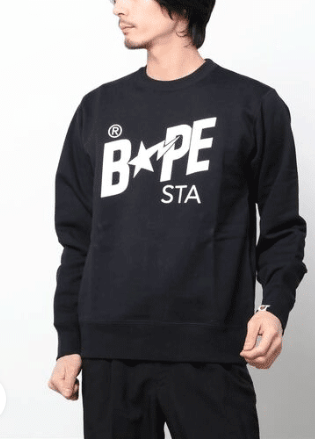The Legacy of Bape Ape: A Cultural Icon in Streetwear
Introduction The world of streetwear has evolved significantly over the years, but few brands have had as profound an impact...

Introduction
The world of streetwear has evolved significantly over the years, but few brands have had as profound an impact as A Bathing Ape, commonly known as BAPE Hoodie Founded in 1993 by Japanese designer Nigo, BAPE has become a global phenomenon, with its iconic Ape Head logo and camouflage patterns dominating the fashion scene. The brand’s unique aesthetic, limited releases, and collaborations with influential figures have solidified its status as a cultural icon. This article delves into the legacy of BAPE, focusing on its signature “Bape Ape” motif and its influence on streetwear culture.
The Origins of BAPE
BAPE was established in the vibrant Harajuku district of Tokyo, a hub for youth culture and fashion experimentation. Nigo, inspired by his love for music, pop culture, and vintage Americana, created a brand that resonated with Japan’s youth. The name “A Bathing Ape” is derived from the Japanese saying “A bathing ape in lukewarm water,” which humorously refers to the complacency of Japan’s youth. From its inception, BAPE distinguished itself with bold designs, vibrant colors, and limited-edition drops, cultivating a sense of exclusivity and desirability.
The Iconic Ape Head Logo
Central to BAPE’s identity is the Ape Head logo, inspired by the 1968 science fiction film Planet of the Apes. The logo, with its minimalist yet striking design, quickly became synonymous with urban fashion. Over the years, BAPE has incorporated the Ape Head into various clothing items, from hoodies and T-shirts to accessories and footwear. The logo’s recognition and association with high-quality, stylish apparel have cemented BAPE’s place in both streetwear and high fashion.
BAPE’s Signature Camouflage Patterns
Another hallmark of BAPE’s design is its custom camouflage patterns, often featuring the Ape Head subtly integrated within the design. Unlike traditional military camo, BAPE’s versions are vibrant and playful, available in a range of bold colors such as green, blue, pink, and purple. This innovative approach to camouflage has become a signature element of the brand, appealing to both fashion enthusiasts and pop culture icons.
Collaborations and Cultural Influence
BAPE’s rise to global prominence was fueled in part by its strategic collaborations with artists, brands, and celebrities. Notable partnerships include collaborations with Pharrell Williams, Kanye West, Adidas, Supreme, and Nike. These collaborations not only expanded BAPE’s reach but also solidified its reputation as a trendsetter within the fashion industry.
The brand’s influence extends beyond fashion, permeating music, sports, and entertainment. Hip-hop artists, in particular, have embraced BAPE, incorporating the brand into their lyrics, music videos, and everyday wardrobes. This association with influential figures has helped BAPE transcend its origins, becoming a symbol of status and creativity worldwide.
Limited Releases and Collectibility
A key factor in BAPE’s enduring appeal is its limited-edition releases, which create a sense of scarcity and exclusivity. Each drop is eagerly anticipated, with fans often queuing for hours to secure coveted items. This scarcity, combined with high demand, has made BAPE products highly collectible, with some items fetching premium prices on the resale market. The brand’s ability to maintain this sense of desirability has been crucial to its long-term success.
Expansion and Global Reach
While BAPE began as a niche brand in Tokyo, it has since expanded its presence globally. Flagship stores in cities such as New York, London, Hong Kong, and Los Angeles have introduced the brand to a wider audience, while online sales have further increased its accessibility. Despite this expansion, BAPE has managed to retain its core identity, balancing mass appeal with the exclusivity that initially defined the brand.
Challenges and Evolution
BAPE’s journey has not been without challenges. In the late 2000s, the brand faced financial difficulties due to overexpansion and increased competition. In 2011, Nigo sold BAPE to the Hong Kong-based company I.T Group, which helped revitalize the brand while maintaining its creative spirit. Although Nigo stepped down as creative director in 2013, his influence continues to shape BAPE’s design philosophy.
The brand has also evolved to stay relevant in an ever-changing fashion landscape. Recent collections have incorporated contemporary trends while staying true to BAPE’s iconic aesthetic. Additionally, collaborations with emerging designers and artists have helped the brand maintain its cultural relevance.
The Future of BAPE
Looking ahead, BAPE shows no signs of slowing down. With a dedicated global fan base and a reputation for pushing the boundaries of streetwear, the brand is well-positioned to continue its legacy. Future collaborations, innovative designs, and strategic expansion into new markets will likely keep BAPE at the forefront of fashion.
Moreover, BAPE’s influence can be seen in the broader streetwear movement, which has become increasingly mainstream. As high fashion and streetwear continue to intersect, BAPE’s role as a pioneer in this space ensures its continued relevance.
Conclusion
The legacy of BAPE and its iconic ericemanuelshop.net Ape motif is a testament to the brand’s ability to innovate, collaborate, and capture the zeitgeist of contemporary culture. From its humble beginnings in Harajuku to its status as a global fashion powerhouse, BAPE has redefined streetwear, blending bold aesthetics with cultural significance. As the brand continues to evolve, its impact on fashion, music, and popular culture will undoubtedly endure, solidifying its place as a true icon in the world of streetwear.




